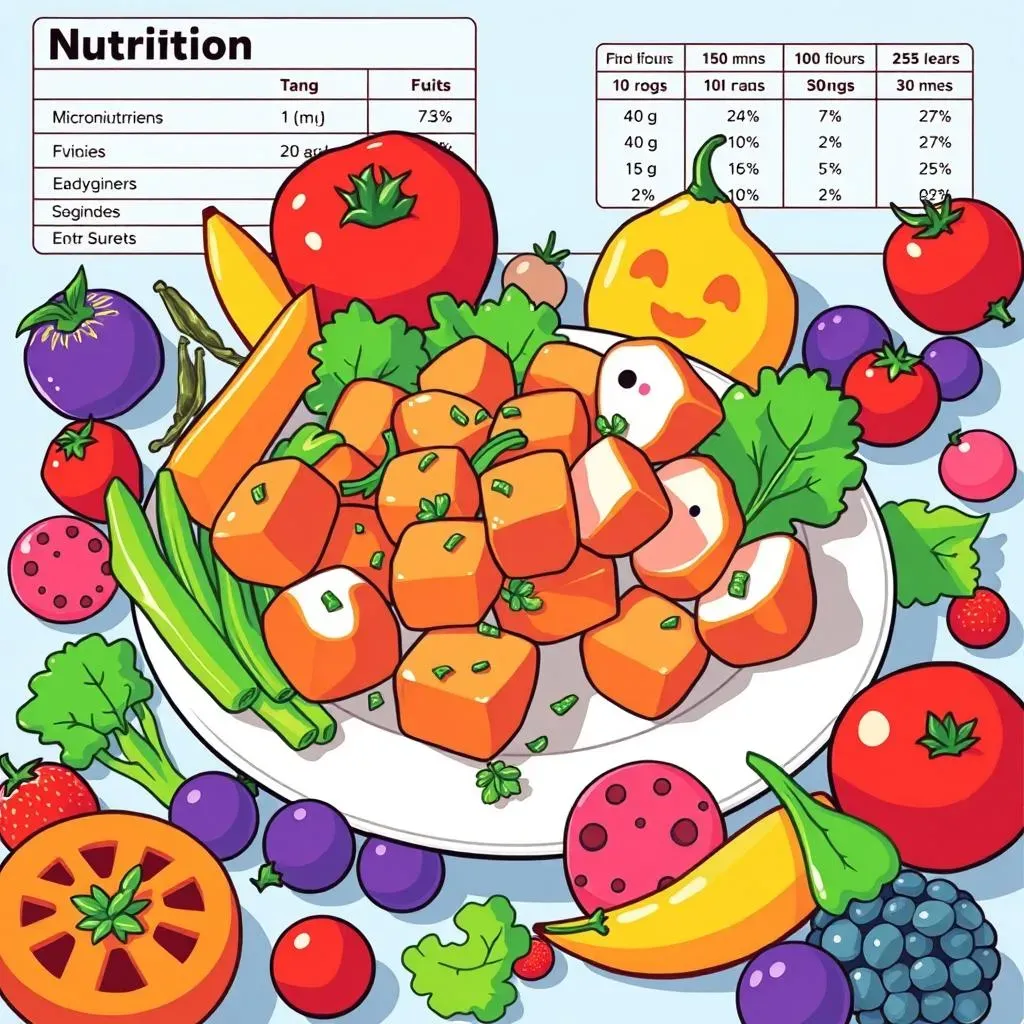Table of Contents
Ever found yourself wondering what's really inside those tasty chicken bites? I know I have, and it's more than just a quick snack craving. We often grab them on the go, but have you ever stopped to consider the "chicken bites nutrition facts"? It's not just about calories; it’s about understanding what you're actually putting into your body. This article isn't about shaming your snack choices, it's about arming you with the knowledge to make informed decisions. We're going to break down the macronutrients like protein, fat, and carbs, explore the vitamins and minerals (or lack thereof), and navigate the sodium and cholesterol content. Think of this as your guide to understanding the nutritional landscape of chicken bites. So, whether you're a health enthusiast or just curious, let's uncover the truth behind those little bites together. By the end, you'll be able to see beyond the deliciousness and into the nutritional reality.
Understanding Chicken Bites: Calories and Macronutrients
Understanding Chicken Bites: Calories and Macronutrients
The Calorie Count: What's the Damage?
Okay, let's talk numbers. When you're eyeing a serving of chicken bites, the first question that usually pops up is: "How many calories are we talking about?" It's a fair question. On average, a serving of about six boneless chicken bites will set you back around 150 calories. Now, that doesn't sound like a lot, but it's what comes with those calories that's important. It's easy to just focus on the calorie count, but the real story is in the breakdown of macronutrients. Think of calories as the overall energy, but the macronutrients are what actually fuels your body and affects how you feel.
It's like knowing you have a full tank of gas, but not knowing if it's regular or premium. You'll still drive, but the performance and long-term impact will be very different. So while 150 calories might fit into your daily goal, understanding where those calories come from makes all the difference. Remember, not all calories are created equal! Some will leave you energized and satisfied, while others might leave you feeling sluggish and wanting more soon after. Let's get into the nitty-gritty of those macronutrients.
Macro Breakdown: Fats, Carbs, and Protein
Now, let’s dive into the macronutrient mix. Those 150 calories from our six chicken bites are made up of fat, carbohydrates, and protein. A typical serving has about 4 grams of fat, 17 grams of carbohydrates, and 11 grams of protein. Looking at those numbers, you see that carbs are the highest, then protein, and then fat. It's not always the same for every brand, but it's a good baseline to work with. The fat content is relatively low, which might sound great, but remember that fats are essential for your body, but not all fats are good for you. The carbohydrates, while providing energy, might not all be the complex kind we want, and the protein, at 11g, is definitely a plus, especially for those of us who are active.
Protein is your friend for muscle repair and feeling full, so that number is a good sign. Understanding this balance can really help you see how chicken bites fit into your overall diet. Are they a great source of protein? Yes, absolutely. Are they also loaded with complex carbohydrates? Not really, they tend to be simple carbs. This means they will digest quickly and might not give you that sustained feeling of fullness. Knowing this helps us make better choices. It's about looking beyond the calorie count and into what the macronutrients are doing for your body. It is like looking at a car and knowing it has an engine but not knowing what kind of engine it is, and that makes all the difference.
Nutrient | Amount per Serving (6 pieces, 80g) | % Daily Value (DV) |
|---|---|---|
Calories | 150 | - |
Fat | 4g | - |
Carbohydrates | 17g | - |
Protein | 11g | 20% |
Chicken Bites: Vitamins, Minerals, and Other Nutrients
Chicken Bites: Vitamins, Minerals, and Other Nutrients
Beyond the Big Three: Vitamins and Minerals
Alright, so we've tackled the macros, but what about the micronutrients? When it comes to vitamins and minerals in chicken bites, the story isn't as exciting as the protein punch. You'll find that they're not exactly nutritional powerhouses in this department. They have a small amount of Vitamin C, clocking in at about 2% of your Daily Value (DV), and a little bit of iron, around 4% DV. That's not a lot. It's like expecting a superhero and getting a sidekick – they're there, but they're not exactly leading the charge. This isn't to say they're completely devoid of nutrients, it's just that they aren't the best source for your daily dose of vitamins and minerals. When comparing chicken bites to other foods, it becomes evident that they're primarily for protein and calories, not for a wide range of micronutrients.
Think of it this way: if your body is a car, the macronutrients are the fuel, and the micronutrients are the oil, coolant, and other fluids that keep everything running smoothly. Chicken bites provide a good amount of fuel but are not the best place to get those other vital fluids. So while they're great for a protein boost, you'll need to look elsewhere for a balanced supply of vitamins and minerals. This also means we should be mindful about the other foods we eat to ensure we get everything our body needs. It's about balance, not just focusing on one aspect of nutrition. It is similar to building a house, you need more than just wood, you need cement, bricks, windows etc.
Nutrient | Amount per Serving (6 pieces, 80g) | % Daily Value (DV) |
|---|---|---|
Vitamin C | 2mg | 2% |
Iron | 0.3mg | 4% |
Sodium and Cholesterol: The Not-So-Good Guys
Now, let's talk about the stuff that isn't so great. Chicken bites tend to have a fair amount of sodium. We are looking at about 510mg of sodium per serving, which accounts for about 22% of your daily recommended value. That's a pretty decent chunk of your daily limit right there. Then there is the cholesterol, coming in at 25mg, which is about 8% of your daily recommended value. Now, while cholesterol isn't the big bad wolf we once thought it was, it's still something to keep an eye on, especially if you have a history of heart-related issues. The high sodium content, on the other hand, is something we should all be mindful of. High sodium intake can lead to a bunch of health problems, and it's often hidden in many processed foods.
It's like having a beautiful garden, but noticing that there are some weeds hiding in there. You need to be aware of them to make sure they don't take over. The sodium and cholesterol in chicken bites aren't necessarily deal-breakers, but it is something to consider when choosing your meals. It is important to remember that these numbers can vary depending on the brand and preparation method. So, it's always a good idea to check the nutrition label. The goal is to enjoy our favorite foods while keeping the not-so-good stuff in check. It’s about being aware and making balanced choices. It is like driving a car, you need to watch out for the other cars, so you can avoid accidents.
- Sodium: 510mg (22% DV)
- Cholesterol: 25mg (8% DV)
Making Informed Choices About Chicken Bites
Making Informed Choices About Chicken Bites
Portion Control: It's All About Balance
Okay, so we've seen the nutrition facts, and now it's time to talk about making smart choices. The first thing to remember is portion control. It's easy to mindlessly eat a whole pile of chicken bites, but being aware of how much you're consuming makes a huge difference. If you look at the nutritional information, you will see that they give you data for 6 pieces, but it is easy to eat more than that. Eating more than that will increase all the bad elements, like sodium, cholesterol, and the calories, plus the carbs and fat. It is like filling a gas tank, if you overfill it, the gas spills over, and the same happens with your body, if you eat too much, it will spill over, and the body will store it as fat. So, the key is to be mindful of the serving size. If you're really craving them, try having a smaller portion alongside a big salad or some veggies. This way, you get to enjoy your chicken bites without going overboard.
It is like having a treat, it is okay once in a while, but not every day or every meal. Remember, it's not about depriving yourself, it's about finding that balance. Think of it as a way to enjoy your favorite foods responsibly. It is like driving a car, you need to make sure you have gas, but you do not need to fill it up to the brim every single time. So, portion control is not just about limiting your intake; it is about making sure you are enjoying your food without sabotaging your health goals. It's about making choices that are sustainable and enjoyable.
Comparing Brands and Preparation Methods
Not all chicken bites are created equal, that is for sure. There are some brands that have more sodium, fat, or carbs than others. And the way they are prepared can make a big difference. For example, baked chicken bites are going to be healthier than fried ones, and some brands use more natural ingredients than others. So, it’s not just about the chicken itself; it’s about the whole package. The breading, the sauces, and the cooking method can all play a role in the final nutritional value. It’s like comparing different cars, some are more fuel efficient than others, and some have more safety features. You need to look at all the details before making a decision.
So, before you grab that box of chicken bites, take a moment to check the nutrition label. Compare different brands and see which one aligns best with your health goals. Look for options that are lower in sodium and saturated fats, and maybe even those that use whole grains in the breading. If you're making them at home, consider baking instead of frying, and use a light hand with the sauces. It is like choosing a route for a road trip, you want to choose the safest and most efficient route. So, being informed about different brands and preparation methods can help you make better choices. It’s not about being perfect, it’s about being mindful and making the best choices you can.
- Read Labels: Always check the nutrition information.
- Compare Brands: Look for lower sodium and fat options.
- Choose Preparation: Baked is better than fried.
- Home Cooking: Control ingredients and cooking methods.
Balancing Chicken Bites with a Healthy Diet
Now, let's talk about the big picture. Chicken bites aren't the only thing we eat, right? So, it's important to see how they fit into our overall diet. If you love chicken bites, don't worry, you don't have to give them up completely. The key is to balance them with other healthy foods. Think of it as making a balanced meal, you want to have a variety of healthy food, and you can have a small portion of less healthy stuff. So, pair your chicken bites with a big salad, a side of steamed veggies, or a whole grain wrap. This way, you're getting the protein you need, along with fiber, vitamins, and minerals. It is like building a house, you need to have a strong foundation, sturdy walls, and a solid roof, everything needs to be in balance.
Also, be mindful of what you eat during the rest of the day. If you know you're going to have chicken bites for lunch, maybe choose a lighter breakfast and dinner. It's all about making conscious choices throughout the day. Don’t forget to drink plenty of water, it helps with digestion and keeps you feeling full. It is like making a budget, you need to make sure you are not overspending in one area so you can have enough money for everything else. So, balancing chicken bites with a healthy diet is not about restrictions; it’s about making smart choices that support your overall health and well-being. It is like driving a car, you need to make sure you have the proper fuel and fluids so you can drive a long way.
Wrapping Up: Making Informed Choices About Chicken Bites
Alright, so we've taken a good look at the chicken bites nutrition facts. It's clear that these little guys can pack a punch, both in flavor and in nutrients—or sometimes, the lack of them. The key takeaway? Being aware of what you're eating is crucial. Knowing the calorie count, the protein punch, and the sodium levels lets you make smarter choices. Chicken bites aren't inherently "bad," but like anything, moderation and mindfulness are your friends. Now you're equipped to make decisions that fit your lifestyle, whether that’s a quick snack or part of a balanced meal. Keep an eye on those labels, and enjoy your food with a little bit of knowledge on your side.